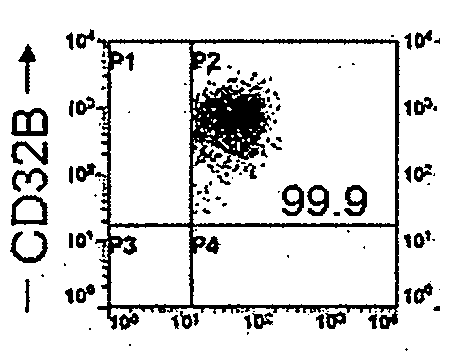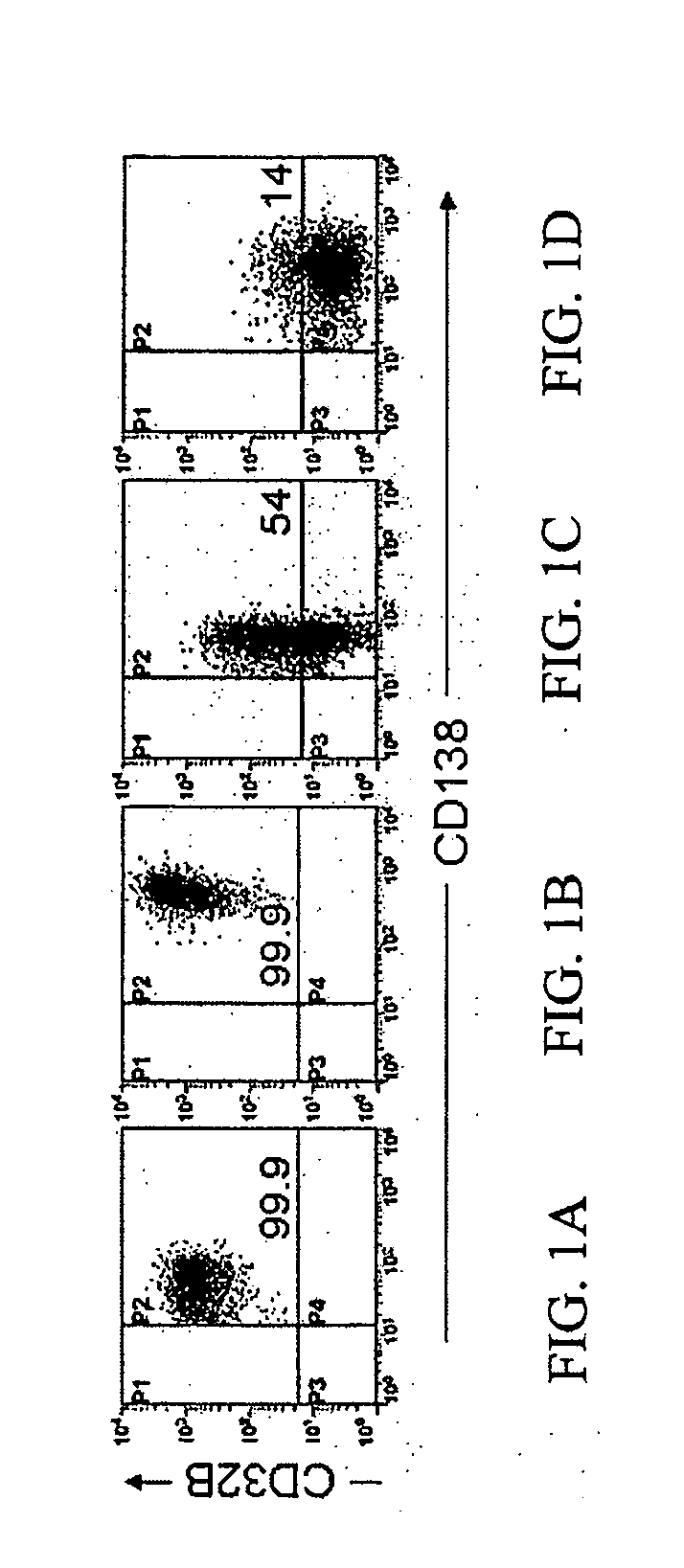[0036]The invention particularly provides methods of treating, preventing or ameliorating a plasma cell disorder, or one or more symptoms thereof, in particular, systemic light-chain
amyloidosis (AL),
multiple myeloma (MM) or plasma cell
leukemia (PCL). Particularly, the methods of the invention are advantageous in subjects with early stage disease to slow or prevent the progression of the disease, to slow or prevent the damage to tissues or organs from the accumulation of
amyloid protein, and / or to reduce the need for other therapy. In specific embodiments, the methods of the invention prevent or slow the progression of said plasma cell disorder to a more aggressive disease state. For example, the treatment of a subject according to the methods of the invention may prevent or
delay the progression of multiple myeloma (MM) from an
asymptomatic state, e.g.,
monoclonal gammopathies of undetermined significance (MGUS), smoldering multiple myeloma (SMM), indolent multiple myeloma or early stage MM (stage I), to a later stage MM (
stage II or stage III) in a subject by 2 months, 4 months, 6 months, 8, months, 10 months, 12 months, 15 months, 18 months, 21 months, 24 months, 2.5 years, 3 years, 4 years, 5 years, 6 years, 8 years, or 10 years or longer relative to a subject with similar clinical parameters who did not receive treatment. In a specific embodiment, the treatment of a subject according to the methods of the invention may prevent or
delay the progression of gammopathies of undetermined significance (MGUS) to multiple myeloma (MM) in a subject by 2 months, 4 months, 6 months, 8, months, 10 months, 12 months, 15 months, 18 months, 21 months, 24 months, 2.5 years, 3 years, 4 years, 5 years, 6 years, 8 years, or 10 years or longer relative to a subject with similar clinical parameters who did not receive treatment. In another embodiment, the treatment of a subject according to the methods of the invention may prevent or
delay the progression of multiple myeloma (MM) to plasma cell
leukemia (PCL) in a subject by 2 months, 4 months, 6 months, 8, months, 10 months, 12 months, 15 months, 18 months, 21 months, 24 months, 2.5 years, 3 years, 4 years, 5 years, 6 years, 8 years, or 10 years or longer relative to a subject with similar clinical parameters who did not receive treatment.
[0042]In another embodiment, the CD32B binding agents of the invention, preferably, anti-CD32B antibodies, analogs, derivatives, or fragments thereof, antagonize at least one activity of FcγRIIB. In one embodiment, said activity is activation of
B cell receptor-mediated signaling. In a particular embodiment, the CD32B binding agents of the invention, preferably, anti-CD32B antibodies, analogs, derivatives, or fragments thereof, enhance
B cell activity,
B cell proliferation,
antibody production,
intracellular calcium influx, or activity of one or more downstream signaling molecules in the FcγRIIB
signal transduction pathway. In yet another particular embodiment, the CD32B binding agents of the invention, preferably, anti-CD32B antibodies, analogs, derivatives, or fragments thereof, decrease
phosphorylation of FcγRIIB or SHIP recruitment. In a further embodiment of the invention, the CD32B binding agents of the invention, preferably, anti-CD32B antibodies, analogs, derivatives, or fragments thereof, enhance MAP
kinase activity or Akt recruitment in the
B cell receptor mediated signaling pathway. In another embodiment, the CD32B binding agents of the invention, preferably, anti-CD32B antibodies, analogs, derivatives, or fragments thereof, antagonize FcγRIIB-mediated inhibition of FcεRI signaling. In a particular embodiment, the CD32B binding agents of the invention, preferably, anti-CD32B antibodies, analogs, derivatives, or fragments thereof, enhance FcεRI-induced
mast cell activation,
calcium mobilization,
degranulation,
cytokine production, or
serotonin release. In another embodiment, the CD32B binding agents of the invention, preferably, anti-CD32B antibodies, analogs, derivatives, or fragments thereof, inhibit
phosphorylation of FcγRIIB, inhibit recruitment of SHIP, inhibit SHIP
phosphorylation and its association with Shc, enhance activation of MAP
kinase family members (e.g., Erk1, Erk2, JNK, p38, etc.). In yet another embodiment, the CD32B binding agents of the invention, preferably, anti-CD32B antibodies, analogs, derivatives, or fragments thereof,
tyrosine phosphorylation of p62dok and its association with SHIP and rasGAP. In another embodiment, the CD32B binding agents of the invention, preferably, anti-CD32B antibodies, analogs, derivatives, or fragments thereof, enhance FcγR-mediated
phagocytosis in monocytes or macrophages. In another embodiment, the CD32B binding agents of the invention, preferably, anti-CD32B antibodies, analogs, derivatives, or fragments thereof, prevent
phagocytosis, clearance of opsonized particles by splenic macrophages.
[0055]As used herein, the terms “aggressivity” and “biologic aggresivity” in reference to a disease or disorder involving malignant or neoplastic cells refer to an evaluation of the
phenotype of the
malignant cells relative to the expected
phenotype of a non-malignant, e.g., normal, cell of the same lineage.
Malignant cells may be classified or staged by a number of phenotypic characteristics relative to normal cells including, but not limited to insensitivity to apoptotic signals, presence / absence of autocrine regulatory pathways, insensitivity to anti-growth signals, capability for tissue invasion /
metastasis, increased replicative potential, decreased
doubling time, expression / lack of differentiation markers, and increased angiogenic potential. The greater the total number of such characteristics and / or the greater the
divergence of said characteristic from the expected norm, i.e., said characteristic in a
normal cell of the same lineage, the more “aggressive” the cell
population will be considered.
[0073]As used herein, a “therapeutically effective amount” refers to that amount of the therapeutic agent sufficient to treat or manage a disease or disorder associated with or characterized by CD32B expression and / or any disease related to the loss of regulation in the
Fc receptor signaling pathway or to enhance the therapeutic
efficacy of another therapy, e.g.,
therapeutic antibody,
vaccine therapy or prophylaxis, etc. A therapeutically effective amount may refer to the amount of therapeutic agent sufficient to delay or minimize the onset of disease, e.g., delay or minimize the spread of
cancer. A therapeutically effective amount may also refer to the amount of the therapeutic agent that provides a therapeutic benefit in the treatment or management of a disease. Further, a therapeutically effective amount with respect to a therapeutic agent of the invention means that amount of therapeutic agent alone, or in combination with other therapies, that provides a therapeutic benefit in the treatment or management of a disease, e.g., sufficient to enhance the therapeutic
efficacy of a
therapeutic antibody sufficient to treat or manage a disease. Used in connection with an amount of CD32
B antibody, the term can encompass an amount that improves overall therapy, reduces or avoids unwanted effects, or enhances the therapeutic
efficacy of or synergies with another therapeutic agent.
 Login to View More
Login to View More  Login to View More
Login to View More 

